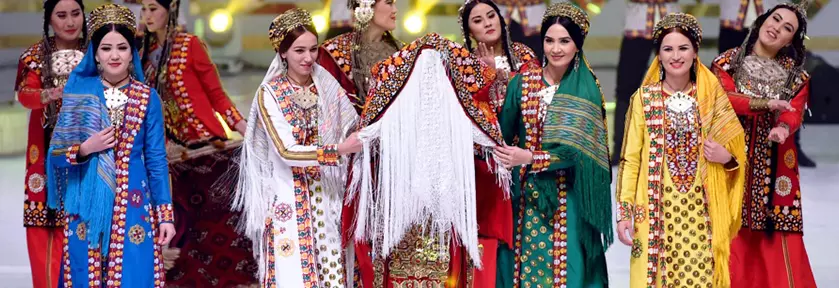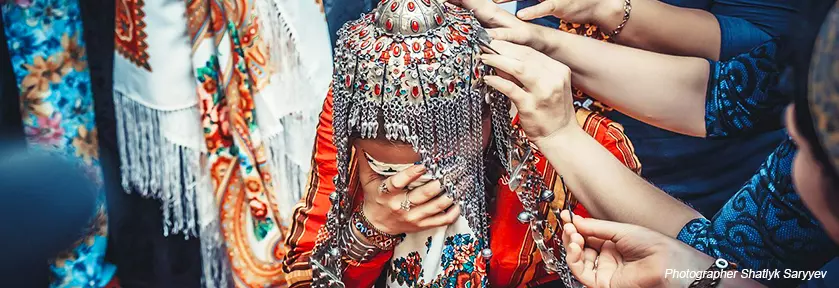A Turkmen wedding is the most important and solemn event. For many generations, each part of the wedding ceremony is accompanied by special rituals designed to bring happiness to the new family.
Turkmen wedding
Traditional Turkmen wedding ceremonies are most prominently celebrated in rural areas, where older generations still cherish their customs. In cities, wedding ceremonies, known as "Toy," are also lively and vibrant. What warms the heart is that these Turkmen traditions aren't fleeting trends but rather robust connections to their ancestral heritage. It's noteworthy that each region in Turkmenistan has unique wedding ceremony details influenced by ancient tribal distinctions, making them especially intriguing for ethnographers, cultural scientists, and historians.
Turkmen Wedding Traditions: A Cultural Celebration Across Generations
The traditional Turkmen wedding process typically starts with a crucial stage known as "Gudachylyk" or matchmaking. Before this significant step, a discreet investigation occurs among neighbors. These neighbors share insights about the prospective bride, describing attributes like her diligence, respect for elders, and obedience. If the groom's family finds this information favorable, esteemed community members, usually elders, visit the girl's residence. During their initial visit, they follow a specific ritual and avoid openly discussing their intentions to thwart potential interference from malevolent forces. Over several visits, the girl's side evaluates the guests' intentions and the groom's suitability. On the third visit, the girl's parents express their consent by offering the guests a white handkerchief.
Turkmen wedding ceremony
The formal engagement process begins with the groom's side presenting gifts, which may include sweets, bread, and sugar, to a respected relative of the bride. These individuals, referred to as "Gudalar," often comprise the groom's elder brother and his spouse or another senior family member with their spouse. The wedding date is selected based on astrological factors, aligning the celebration with favorable cosmic influences. One common phrase during this process is: "Bizde kumush, sizde - altyn, olary bir kushyk," translating to "We have silver, you have gold, let's unite them as one."
Wedding Preparations
Once the girl's parents grant their consent, discussions proceed about the wedding preparations, known as the "Toy," and the selection of gifts, referred to as "Gelin-Geim," for the bride. A significant symbol of this commitment is the placement of a white handkerchief on the bride-to-be's head, signifying her official engagement.
The gifts encompass a range of items such as gold jewelry, clothing suitable for various seasons, fabrics, scarves, and more. Additionally, the groom's side presents gifts to the bride's mother and female relatives as part of a tradition called "Atgulak."
Dowry and Bride's Assembly
The bride, with the assistance of close relatives and friends, assembles a dowry containing carpets, chuval (stripe-woven flat bags), and kitchenware. This dowry adheres to customs and is proudly displayed when the bride relocates to her husband's home.
The traditional Turkmen wedding ceremony commences in the bride's home. During the transfer of the bride to the groom's house, friends and villagers often attempt to stop the procession, receiving gifts like woven scarves or pieces of cloth. The most cherished gift is a scrap from the wedding dress, believed to hasten marriage.
A camel wedding caravan, known as "Kejebe," accompanied by guards, arrives at the groom's house, where the main festivities unfold. A large platform is constructed in the courtyard for the official ceremony. The newlyweds recite a solemn wedding prayer before the celebration kicks off.
Groom's Playful Challenge
The initial interaction between the couple involves a playful test by the groom, known as "Gushak Chesdi." He challenges the bride to untie his belt scarf and remove his boots, hat, and gown. Often, the belt is filled with sand to make it harder to untie. The bride's friends assist her, while the groom's friends try to hinder her efforts. This humorous event symbolizes the bride's unconditional obedience to her husband's wishes, adding to the wedding's merriment.
Following the introduction, the groom's friends accompany him to the bride's section of the house, where women put up spirited resistance. After a playful struggle, the groom prevails and takes sugar pieces from the vigilant women, which he traditionally scatters on the wedding bed.
A few days later, the bride replaces her headdress with that of a married woman in a ceremony known as "Bash Salmak." This involves a comical struggle between bridesmaids and women from the groom's side. Only with the intervention of elders does the brawl cease, and the bride's hair is braided with silver jewelry, signifying her transition to married life.
The Final and Most Solemn Day
The celebrations culminate on the third day of the wedding, known as "Gelin-alydzhi," which is the final and most solemn day. Both families and the entire village gather for this occasion. In rural areas, most weddings take place at the groom's house, emphasizing respect for the parental home and strengthening bonds between intermarried families.
In Turkmen weddings, the bride dons a red dress made of homespun silk known as "Keteni." The red color is believed to possess magical properties for protection and good fortune. The dress is adorned with embroidery and silver and gold-plated jewelry to ward off evil spirits and serve as amulets. The bride also wears a handkerchief covering her face and a cape called "Kurte" with embroidered patterns. Older daughters-in-law stand on either side to support her, as the heavy silver headdress and jewelry often cause her to move slowly and bow her head.
Enchanting Performances
Wedding songs are a cherished tradition in Turkmen weddings, with varying names across different regions. Girls and young women perform these songs, often accompanied by tambourine beats, while dances such as "Chapak," "Sallanma gozel," and "Hekjebekush" add to the spectacle.
Turkmen weddings are more than just traditions; they are about singing, dancing, and spreading love and happiness! These ceremonies establish a strong emotional and moral foundation that lasts a lifetime.





